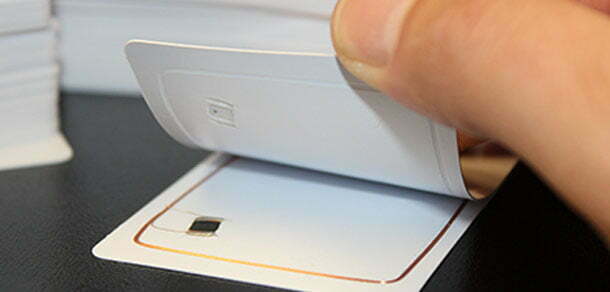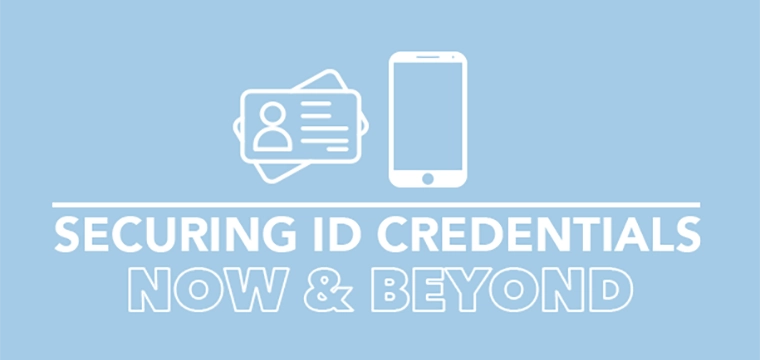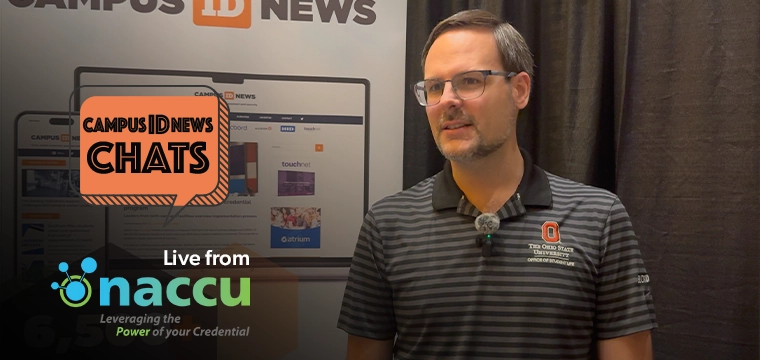
Many campuses utilize proximity cards (also called prox cards) to control access to buildings and facilities. Typically, these have been a stand-alone ID card separate from the official campus ID. Today, however, more and more institutions are opting to merge the two cards, adding the proximity technology to the official ID. While not yet commonplace in the higher education environment, contactless cards are becoming the technology of choice for many transportation fare collection systems, financial ‘wireless’ payments, and many secure credential projects. Both proximity and contactless cards employ the same fundamental technology–radio frequency identification (RFID)–for operation.
RFID systems enable a card and a card reader to communicate without the need for one to physically touch or contact the other–hence the term contactless. The card need only be placed in close proximity to the reader for communication to occur–hence the term proximity. While it is common for the two terms to be used interchangeably, there is actually an important difference between the two technologies. Proximity cards typically enable read-only functionality while contactless cards enable both read and write capabilities.
This distinction has led to the common uses of the technologies. Proximity cards are used mainly in access control applications requiring only that an identification number be transferred from the card to the reader. Contactless cards are often used in more complex applications requiring that information be read from the card and updated information written to the card. While both technologies will work well as an access control token, contactless cards open up the potential for the card’s use in other applications as well.
Here is an analogy to help illustrate the concept of RFID. You may remember the childhood science experiment demonstrating the concept of static electricity. A balloon was rubbed on fabric to generate a buildup of static electricity strong enough that when held near a person’s head would make the hair stand up, attracted to balloon.
An RFID system works in much the same way. The card reader emits electromagnetic energy that forms a field emanating out the reader. When a card is placed inside this field, it uses its internal antenna to draw power from the field sufficient to turn itself from off to on. Once powered up, the card is able to send and receive instructions and information to and from the reader. When the card is removed from this field or held too far from it, sufficient power is no longer available and it turns off. Just like the hair near the balloon, it is the distance from the power source (the card reader or the balloon) thatdetermines if the energy will be sufficient for operation.
So that explains how the card receives power, but how is it able to transfer data through mid air? This is the fundamental key to RFID–the concept of frequency. Radio waves travel through the air at varying rates. Low frequencies have a smaller number of waves (referred to as ‘cycles’) per second while high frequencies have a large number (see Figure 1). Frequency is measured in Hertz (Hz). A single Hertz is equal to one cycle per second.
Radio waves cycle extremely quickly and thus are seldom measured in Hz. Prefixes are added to Hz to make it large enough to describe frequencies in manageable terms. The prefix kilo (k) means 1000. A single kilohertz (kHz), therefore, is equal to 1000 Hz. The prefix mega (m) equals 1 million and, thus, a single megahertz (mHz) is equal to 1 million Hz.
In RFID systems, two common frequencies are 125 kHz and 13.56 mHz. Many read-only proximity cards used in access control arenas operate at frequencies on or around 125 kHz. That means that the radio waves are cycling at 125,000 waves per second. That is a staggering number, yet, the 13.56 mHz technology used in many contactless smart card systems relies on waves cycling at 13,560,000 waves per second! While these frequencies seem astoundingly high, wireless networks and satellite systems operate at frequencies that are measured in gigahertz (GHz), or 1 billion waves per second.
So we see that it is the rate of the radio waves that determines frequency. And we see how this frequency is measured in Hz, kHz, mHz, and gHz. But what does this really mean? Why does a 900 mHz cordless telephone operate at 900 mHz while a 13.56 mHz contactless card operates at 13.56 mHz?
In a RF system, there are two required components–a transmitter and a receiver. The transmitter sends radio waves while the receiver catches them. In order for a transmitter and a receiver to communicate–to send and receive radio waves–they must both be ‘speaking’ at the same frequency.
To illustrate this point, think of the transmitter as a whistle and the receiver as an ear. When a normal whistle is blown, it creates noise at a frequency that the human ear can receive. But when a dog whistle is blown, the frequency of the resulting noise is above that which is audible to the human ear. A dog can hear it, but a human cannot.
In a similar manner, the frequency recognized by a transmitter and a receiver must be compatible. When a 13.56 mHz card (the transmitter) is presented to a 13.56 mHz reader (the receiver), signals are recognized. But when a 125 kHz card is presented to the 13.56 mHz reader, they are unable recognize one and other.
So frequency measures the number of waves per second, but thepractical importance of this is that it determines whether transmitters and receivers can speak to each other. At any given moment, the air is filled with radio waves with hundreds of different frequencies. If the waves accepted by a particular receiver were not limited to certain frequencies or frequency ranges, it would be overwhelmed with incoming signals.
In the different regions of the world, governments or quasi-governmental bodies have allocated the spectrum of available frequencies to specific uses. Thus, television receivers are not likely to be bombarded by non-approved signals and RFID card systems are not likely to be jammed by unauthorized or unintended signals from other RF-generating systems.
Radio waves have distinct frequencies so that compatible cards and the readers can recognize each other. But how is meaningful information (e.g. ID numbers) carried through the air on radio waves? This leads to the next key concept of RFID–modulation. Modulation is the act of changing a radio wave in a specific, deliberate manner. These changes are done to create a binary situation–an either/or, on/off, one/zero situation. In much the same way that the magnetic stripe holds data in a series of positive and negative charged areas, a modulated radio wave holds data in a series of modulated and un-modulated cycles.
The most basic form of modulation is achieved by adjusting the height of the radio waves. Height is referred to as amplitude so the term for this process is amplitude modulation. Sound familiar? Amplitude modulation is abbreviated AM and it is the source of the common AM radio signal. With AM radio, audio data is carried on radio waves by adjusting the height or amplitude of the wave. Other common forms of modulation include frequency modulation (you guessed it … FM radio) and phase modulation.
To summarize, a card is held within the electromagnetic field created by a card reader and it draws power from this filed. Once powered on, the card and reader communicate by sending radio waves at a shared frequency or range (e.g. 125 kHz). The data is carried on these radio waves by modulating certain waves and leaving others un-modulated. This forms a binary situation that enables data to be encoded in the waves. In this manner, RFID systems enable data to shared without the card and reader ever touching each other.
And as most campus card system administrators can attest, any ID transaction that can be conducted without the card needing to be inserted into or swiped through a reader can have great benefits. With no openings or exposed components, the chance for damage due to weather, vandalism, or normal operation is greatly diminished. Additionally, user convenience is increased and the need for user education is reduced. All this guarantees that we will be seeing a great deal more proximity and contactless cards on campuses across the country.




